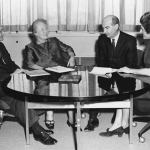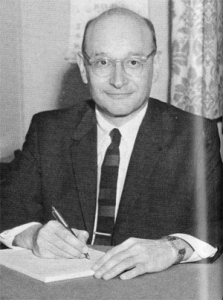Joseph Steinberg: Part of the Golden Age of the Census Bureau
U.S. Census Bureau Interns Ariel Lee, James Madison University, and Greg Boyd, University of Maryland University College
In 1940, the U.S. Census Bureau entered a period of transition. According to an interview with Edwin D. Goldfield, former chief of the International Statistical Programs Center, the bureau was in the process of offering thousands of positions to “any people […] on any civil service register” to process the 1940 census. Although positions were temporary and compensation amounted to little, people were simply happy to be employed during the hardships of the Great Depression. This influx of workers brought talent and skills to the Census Bureau that birthed the renowned “Class of 1940” and the beginning of the Census Bureau’s “Golden Age.” Joseph Steinberg was part of this age and among those who changed the world of statistics.
Steinberg had a distinguished career as a public servant and in the private sector. While a public servant, he shared time between the Census Bureau, Social Security Administration (SSA), and Bureau of Labor Statistics (BLS). Following his time in government, he created his own firm, Survey Design, Inc., where he was president until 1995.
Even considering all of his achievements, Steinberg accomplished the most as a leader and teacher. David Nolle, a sociologist who worked closely with Steinberg, expressed his appreciation for Steinberg’s willingness to explain difficult concepts and processes in a digestible manner. Nolle consulted with Steinberg for many years on multiple projects, including handling sampling issues related to surveys conducted by the U.S. Information Agency, incorporating nonresponse corrections in specific case studies, and producing unbiased results—without weights—in an overseas contractor’s sampling plan.

From left: Steinberg, Ida Merriam, Jack Carroll, and Lenore Epstein, Bixby Office of Research and Statistics, 1970
Steinberg was a leader in sample design. For example, he was among those involved in formulating the sample design of the Current Population Survey (CPS), a monthly sample survey conducted by the Census Bureau used to obtain estimates and data about characteristics of the labor force. Furthermore, in Sample Survey Methods and Theory: Volume I, Steinberg authored a thorough overview of how the monthly CPS operates, in a way similar even today.
Part of what contributed to Steinberg’s success was his use of generalized variance functions (GVFs). Kirk Wolter, executive vice president of survey research at the National Opinion Research Center, acknowledged the significance behind using GVFs in his Introduction to Variance Estimation when he referenced the CPS as evidence for why the method of GVFs is ideal for large surveys in which direct computation of variance is unmanageable.
During his time in the federal government, Steinberg broke new ground on record linkage applications. Perhaps the impact of jumping back and forth from one federal agency to another brought him to realize the importance of interagency record linkage. He was convinced that to move forward and expand on coverage and accuracy, many agencies would need to combine forces, efforts, and data subjected to careful controls to protect privacy and confidentiality.
Steinberg also is known for being an advocate for the approach of linking CPS, Internal Revenue Service (IRS), and SSA records to produce more accurate income information. According to the Studies from Interagency Data Linkages series, Steinberg states that the linking process is more efficient if it involves starting with “an administrative record population, rather than a survey process [that was] … attempt[ing] to measure the same population.” The Census Bureau has long since realized the truth and potential behind Steinberg’s words and made it a goal to use administrative records more during the 2020 Decennial Census to save money and improve accuracy.
Record linkage is not new in censuses and surveys, predating Steinberg’s involvement. For example, nearly 100 years earlier, a Norwegian statistician named Anders Nicolai Kiaer introduced modern probability sampling with the matching of sampled Norwegian tax records to the Norwegian census of 1890.
Steinberg may have been influenced, or at least inspired by, Kiaer’s revolutionary concepts of data collection, particularly concerning population coverage. Kiaer wanted to expand the coverage of his sample to have a fair geographic, social, and economic representation of the entire population. He acknowledged the problem of under-representation and general undercount and proposed to remedy the issue by adding participants from the under-represented demographic groups to the sample.
Like Kiaer, Steinberg understood there were specific demographic groups being overlooked or undercounted, which highlighted the importance of linking Census Bureau surveys with IRS, SSA, and other administrative records. In this sense, the goal for both Kiaer and Steinberg was to “increase the scope of the large-scale statistical investigation” they both planned to carry out.
In summary, it can be said that Steinberg provided unrivaled contributions to the field of record linkage, as well as survey design. Although he left us in April of this year at 91 years old, his research and innovation will guide the Census Bureau and many others in record linkage and survey design for years to come.


















